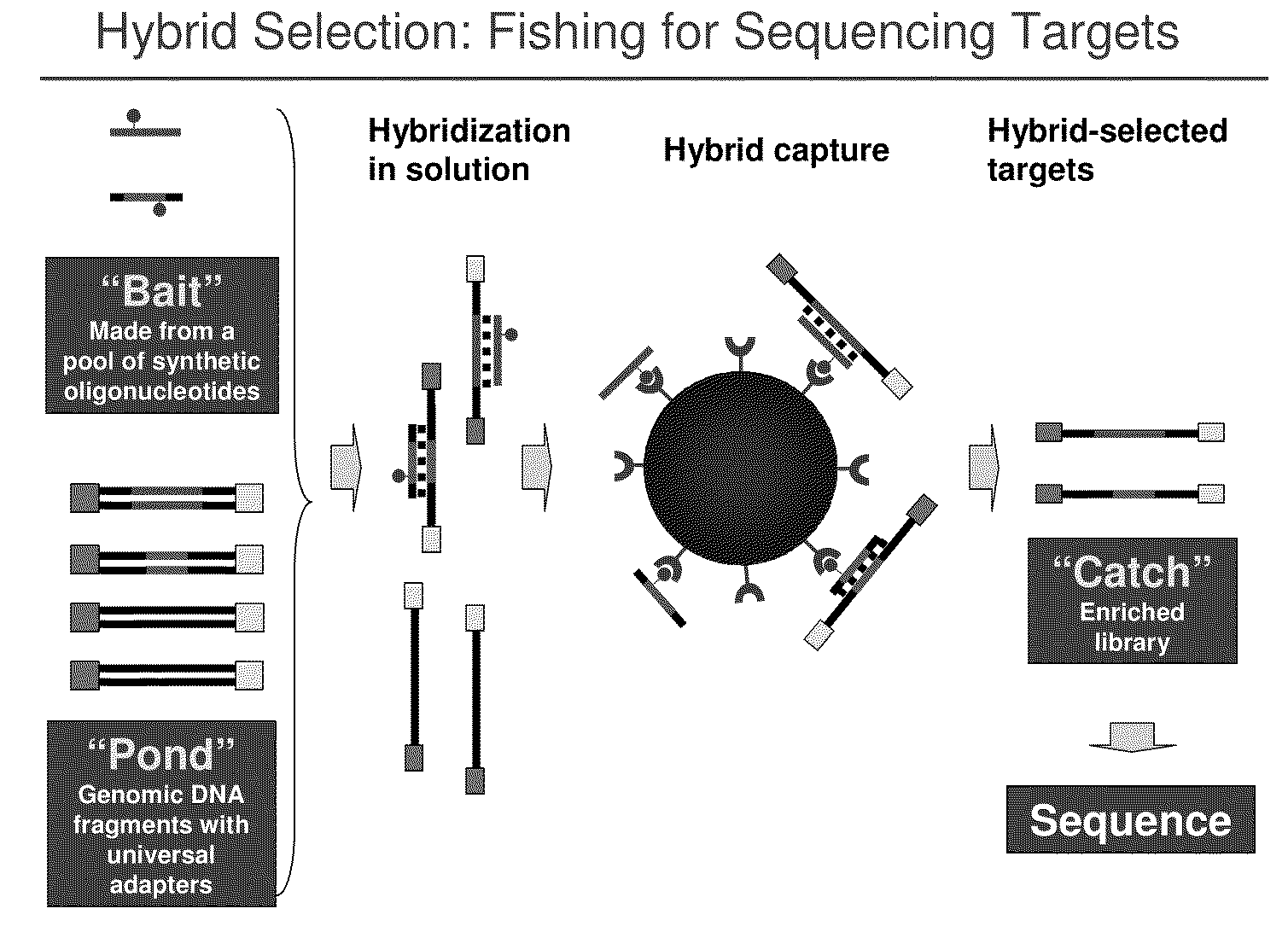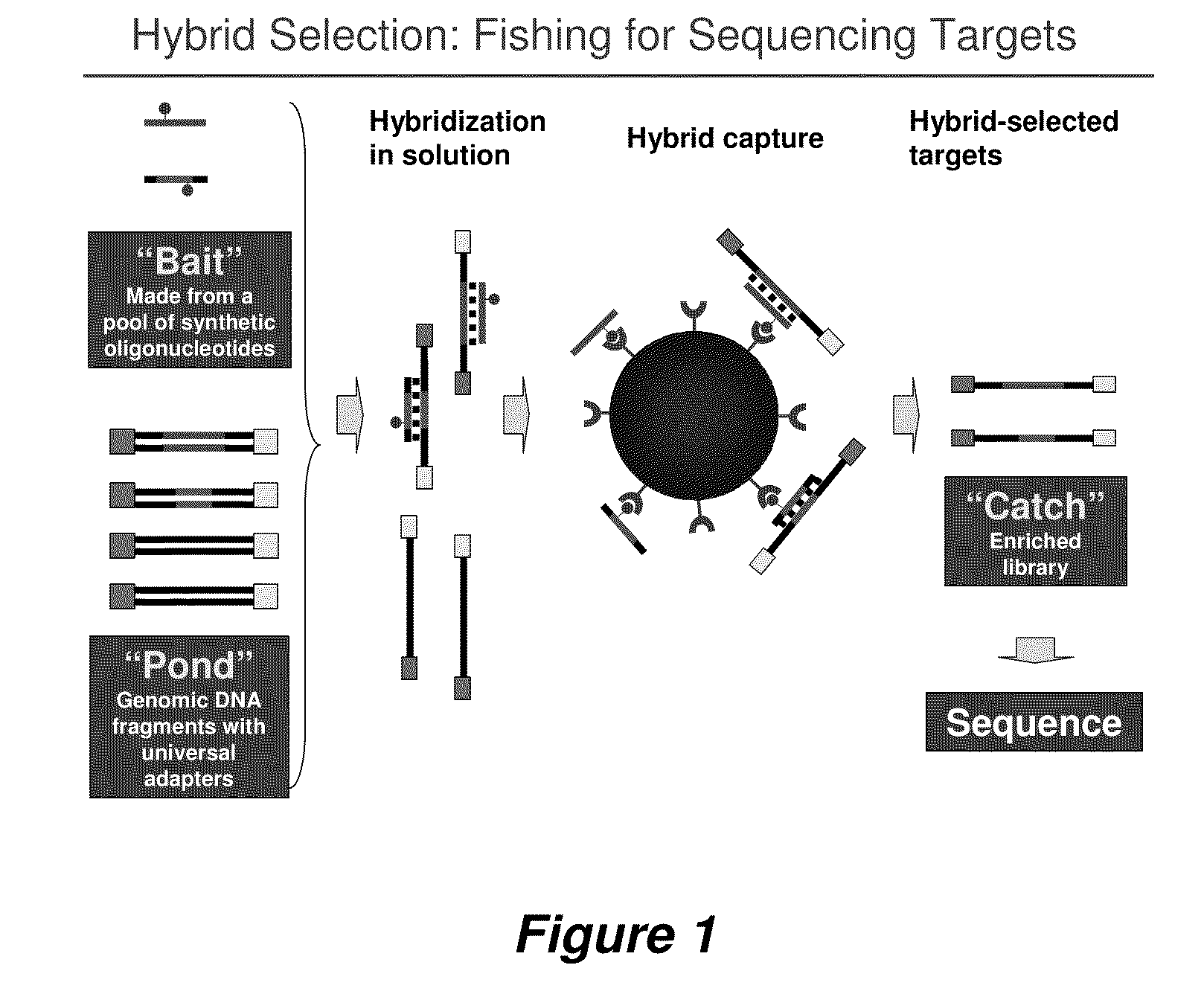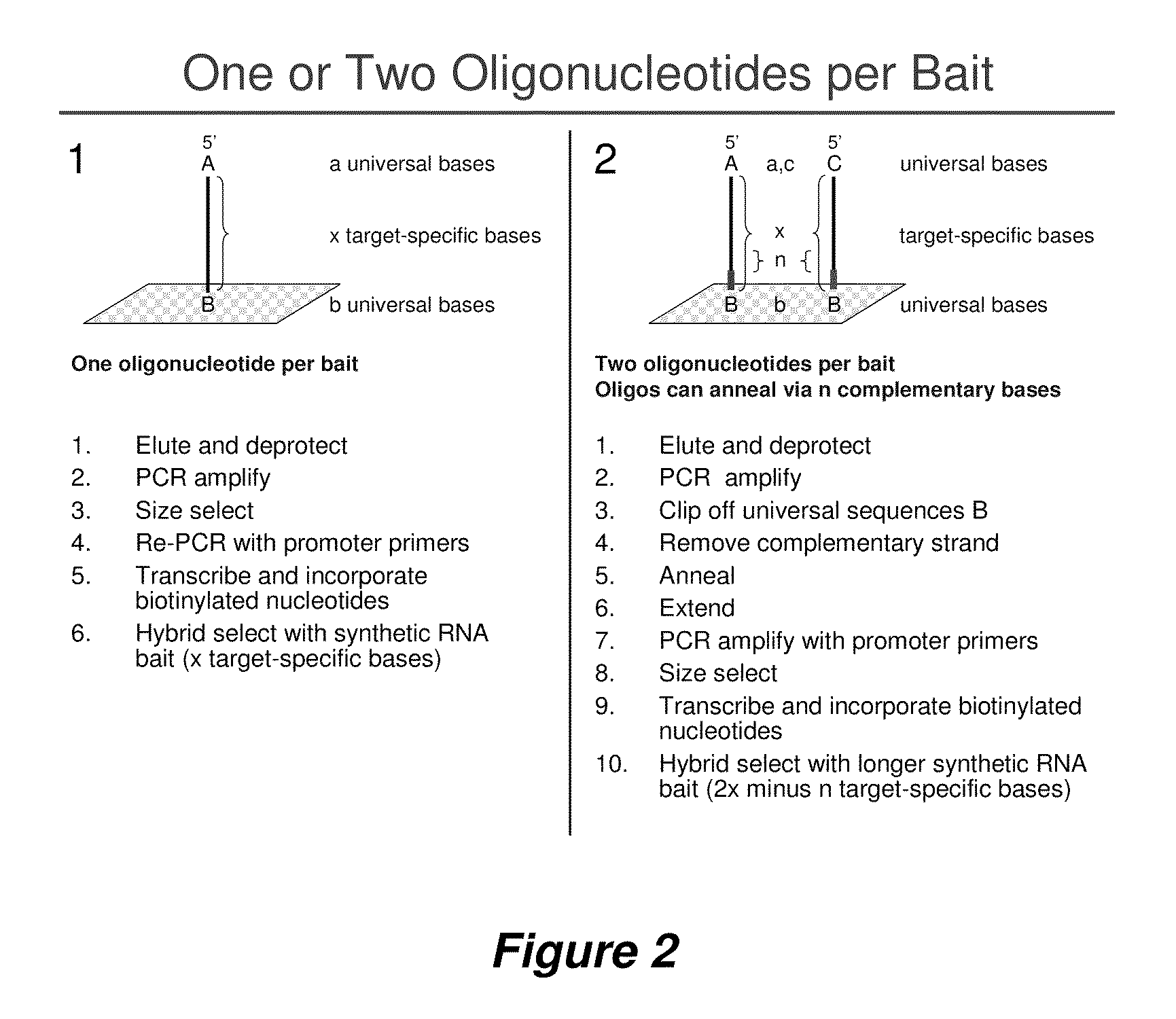Selection of nucleic acids by solution hybridization to oligonucleotide baits
a technology of oligonucleotide bait and nucleic acid, which is applied in combinational chemistry, biochemistry apparatus and processes, library screening, etc., can solve the problems of limiting the utility of systematic comparative sequencing studies, poor reproducibility, and high uneven target recovery, so as to minimize the differences in molarity of different captured sequences, no allele bias or allele dropout, and reproducibility of target representation in captured sequences surprisingly high
- Summary
- Abstract
- Description
- Claims
- Application Information
AI Technical Summary
Benefits of technology
Problems solved by technology
Method used
Image
Examples
example 1
Hybrid Selection Protocol
1. Materials
1.1 Reagents, Enzymes and Kits
MAXIscript® T7 Kit (Ambion, Cat #AM1312)
NucAway™ Spin Columns (Ambion, Cat #AM10070)
TURBO DNAfree™ kit (Ambion, Cat #AM1907)
Formaldehyde Sample Buffer (Lonza, Cat #50571)
FlashGel™ RNA Cassettes
SUPERase•In™ (Ambion, Cat #AM2694)
[0177]Biotin-16-uridine-5′-triphosphate (Roche, Cat #11388908910)
RNA Century™ Marker (Ambion, Cat #AM7780)
[0178]Qubit™ fluorometer (Invitrogen, Cat #Q32857)
Qubit™ assay tubes (Invitrogen, Cat #Q32856)
Quant-iT RNA Assay Kit (Invitrogen, Cat #Q32852)
Quant-iT DNA Assay Kit, Broad Range (Invitrogen, Cat #Q33130)
SSPE Buffer 20× Concentrate (Sigma, Cat #S2015)
Denhardt's Solution 50× Concentrate (Sigma, Cat #D2532)
[0179]Sodium dodecyl sulfate solution 10% (Sigma, Cat #L4522)
5 M NaCl Solution (Ambion, Cat #AM9760G)
Nuclease-free Water (not DEPC-treated) (Ambion, Cat #AM9930)
20×SSC Solution (Ambion, Cat #AM9763)
1 M Tris Solution, pH 8.0 (Ambion, Cat #AM9856)
0.5 M EDTA Solution, pH 8.0 (Ambion, Cat #AM926...
example 2
Solution Hybrid Selection with Ultra-Long Oligonucleotide Probes for Massively Parallel Targeted Sequencing
[0191]The development and commercialization of a new generation of increasingly powerful sequencing methodologies and instruments1-4 has lowered the cost per nucleotide of sequencing data by several orders of magnitude. Within a short time, several individual human genomes have been sequenced on “next-generation” instruments3,5-7 with plans and funding in place to sequence more (www.1000genomes.org).
[0192]Sequencing entire human genomes will be an important application of next-generation sequencing. However, many research and diagnostic goals may be achieved by sequencing a specific subset of the genome in large numbers of individual samples. For example, there may be substantial economy in targeting the protein-coding fraction, the “exome”, which represents only ˜1% of the human genome. The economy is even greater for many key resequencing targets, such as genomic regions impl...
example 3
Production Hybrid Selection Protocol
[0256]This example is the production protocol of the Broad Institute Genome Sequencing Platform. It is written for hybrid selection of 24 samples in parallel but can be easily scaled to 96 samples and hybrid selections. It uses lab automation stations (e.g., Velocity 11 Bravo Deck; Janus) at most of the individual steps. Briefly, the DNA sample is sheared, end-repaired, A-extended, size-selected (non-gel based double SPRI protocol), ligated to Illumina paired-end sequencing adapters, and PCR amplified. The PCR-amplified “pond” is hybridized to a biotinylated RNA bait. Biotinylated hybrids are captured and washed on the automated bead capture apparatus shown in FIG. 12. The catch is PCR amplified and paired-end-sequenced with 2×76-base Illumina reads according to standard methods.
1. Standard Automated Library Construction with Double-SPRI Size Selection
1.1 DNA Shearing on Covaris E210
[0257]1. Ensure that the Covaris has been degassed & the bath tem...
PUM
| Property | Measurement | Unit |
|---|---|---|
| temperature | aaaaa | aaaaa |
| temperature | aaaaa | aaaaa |
| w/w | aaaaa | aaaaa |
Abstract
Description
Claims
Application Information
 Login to View More
Login to View More - R&D
- Intellectual Property
- Life Sciences
- Materials
- Tech Scout
- Unparalleled Data Quality
- Higher Quality Content
- 60% Fewer Hallucinations
Browse by: Latest US Patents, China's latest patents, Technical Efficacy Thesaurus, Application Domain, Technology Topic, Popular Technical Reports.
© 2025 PatSnap. All rights reserved.Legal|Privacy policy|Modern Slavery Act Transparency Statement|Sitemap|About US| Contact US: help@patsnap.com



